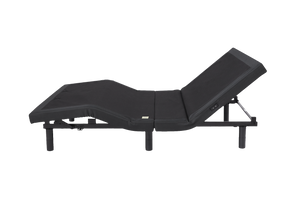Sleep should be peaceful and refreshing, but not painful. Unfortunately, that's not something people with intercostal muscle strain can relate with.
Such individuals are usually uncomfortable in bed, and the pain can worsen when not sleeping on a supportive mattress, like the ones available from Polysleep. Even before we discuss how to sleep with intercostal muscle strain, let’s first find out what this pain is all about.

What Is an Intercostal Muscle Strain?
Intercostal muscle strain is a kind of injury that affects the muscles between two or more ribs. The human rib has 22 muscles — the intercostal muscle is one of them.
These muscles allow your ribcage to contract and expand as you breathe. But sometimes, they stretch too far, leading to muscle strain.
What Are Intercostal Muscle Strain Symptoms?
Individuals with rib muscle strain experience different symptoms, including:
This kind of pain targets the upper back or the rib cage area. It appears suddenly, especially if the injury derives from a sudden blow to the chest or back. This pain is also common among individuals who engage in high-intensity physical activity.
Muscle injuries often lead to stiffness, pain, and spasms. The stiffness occurs around the upper back area, especially during random movements such as bending or stretching.
Most people with rib muscle strain experience difficulty breathing because taking a full breath may be too painful. As a result, rather than taking full breaths, individuals with this condition would instead take shallow breaths, leading to an insufficient supply of oxygen into the body.
Intercostal muscle strain often leads to gradually worsening pain, especially in athletes or individuals involved in regular high-impact activities. Initially, the pain feels like a minor discomfort but then grows into something more severe with repeated physical activity.
In extreme cases, intercostal muscles may swell and become extremely painful, particularly when touched. When that happens, it becomes much more difficult to breathe because breathing expands and contracts the ribcage.
What Causes Intercostal Muscle Strain?
An intercostal muscle strain occurs when you pull and strain your muscles. Here are a few good examples of common triggers.
- Lifting heavy items.
- Extreme workouts.
- Pulled rib muscle from coughing.
- Overstretching the rib cage, especially when reaching for overhead items.
- A direct hit to the rib cage caused by high-impact sports such as football, soccer, kickboxing, karate, etc.

How to Diagnose Intercostal Muscle Strain?
It's important that you seek intercostal muscle strain treatment if you're experiencing any of the symptoms we discussed earlier. Your doctor will conduct several tests.
First, the doctor will monitor your breathing. Irregular breathing could be a sign of a lack of enough supply of oxygen. As stated earlier, people with rib muscle strain struggle to breathe because their ribs hurt in the process.
Your doctor will also gently touch the affected area while observing your reaction. If there's a reason to believe that it's a case of a strain, the doctor may recommend an x-ray to check the condition of your internal organs.
Throughout the diagnosis, your doctor will also want to know whether you participate in contact sports. If so, they'll want to find out how frequently you play sports and if you've recently had any injury.
If the test results are positive, the doctor will evaluate the grading system to establish the best-pulled rib muscle treatment options. There are three grades of intercostal muscle strain. They include:
Grade 1
Individuals with Grade 1 rib muscle strain experience minimal loss of motion. In Grade 1, the damage is around 5 percent. After intercostal muscle strain treatment, the patient may need 2 to 3 weeks to recover.
Grade 2
In Grade 2, the muscle fibers are severely damaged but not raptured — at least not entirely. This kind of damage can cause loss of mobility. In addition, the intercostal strain recovery time for this grade is anywhere between 2 to 3 months.
Grade 3
This is usually the most severe level. A Grade 3 muscle strain means the rib muscles and tendons are completely ruptured, often requiring surgery to treat. The intercostal strain recovery time depends on the specific surgery.

How Long Does Rib Muscle Strain Last?
Rib muscle strain can last longer if you don't know how to sleep better with it.
For example, sleeping on an unsupportive mattress can lead to this kind of pain. This is because some mattresses may feel too tough on your ribs. Sleeping on a tough mattress can cause further pain in your rib area and other parts of the body.
On the other hand, a mattress that's too soft will cause your body to sink too deep, leading to improper alignment of certain external and internal body parts, including your spine. To prevent this kind of pain and discomfort, consider sleeping on a high-quality memory foam mattress, such as the Zephyr Mattress.
Once you learn how to sleep with intercostal muscle strain, you’ll have an easier time falling asleep.
The grading system explained above also determines how long this pain will last. Usually, the higher the grade, the longer the pain.
How to Avoid Intercostal Muscle Strain?
The best way to avoid muscle strain is by identifying potential causes that relate to your lifestyle.
For example, consider adopting various defensive tactics to protect your rib cage when participating in contact sports if you're an athlete.
Avoid lifting heavy items, whether at home or when working out. The Occupational Safety and Health Administration recommends lifting not more than 51 pounds. If you have to lift heavier items, consider seeking help or using a machine.
Don't go directly into lifting heavy weights or overstretching your body when working out. Instead, start slowly, allowing your body to adjust to prevent intercostal muscle strain stretches.
You may also consider exercises. Some good examples of exercises for rib muscle strain include yoga and belly breathing.
Most importantly, consider the quality of your sleep. The average American spends about 6.8 hours a day sleeping.
For this reason, you need a mattress and sleep accessories that contour and support your rib cage, spine, neck, back, and other parts of your body.
This antimicrobial memory foam mattress is a great example of a mattress designed for the ultimate comfort and support.

Other relevant articles:
Key Takeaways
A strained rib muscle shouldn't be taken lightly — it can lead to breathing difficulties.
In addition, when your body lacks sufficient oxygen, you'll most likely experience constant headaches, restlessness, and confusion. In extreme cases of severe oxygen deprivation, the brain goes to sleep, leading to a coma.
Lastly, while you can't avoid some accidents, you can change certain aspects of your life, such as the quality of the mattress you sleep on. Learning how to sleep with intercostal muscle strain can help alleviate this pain as you undergo treatment.
If you liked our blog article, please don't forget to
Share it with your friends by clicking the button below!






























